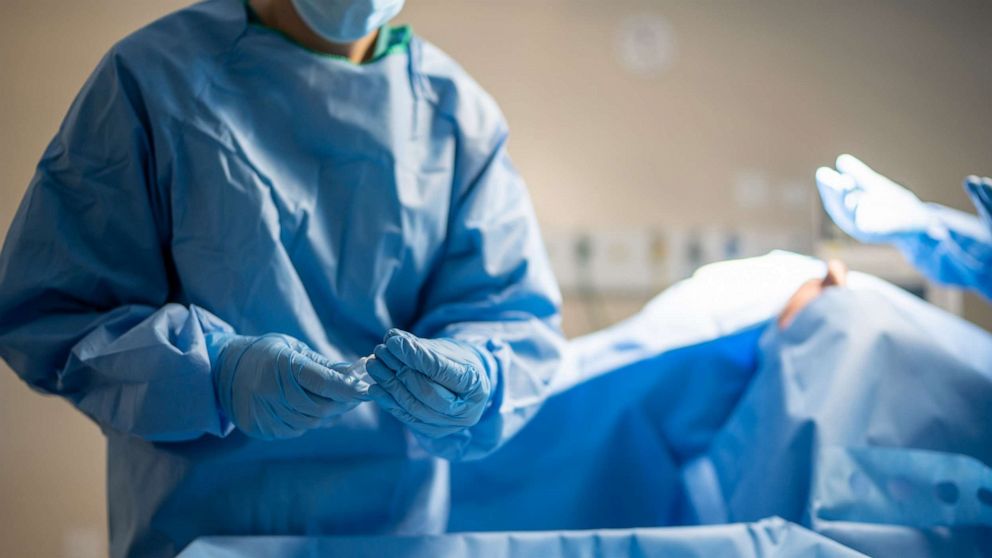


A surgical tool "the size of a dinner plate" has been discovered inside a woman's abdomen 18 months after undergoing a caesarean section while giving birth to her child, health officials have confirmed.
The unnamed woman from New Zealand, who was in her 20s when she gave birth to her child in 2020, underwent a scheduled C-section at 36 weeks plus three days gestation, according to a report released by New Zealand's Health and Disability commissioner, Morag McDowell.
MORE: Woman who allegedly stabbed grandfather in the face after he asked her to shower is arrested"An Alexis wound retractor (AWR), a device used to draw back the edges of a wound during surgery, was left in her abdomen following her C-section," the report said. "This resulted in the woman suffering chronic abdominal pain until the device was discovered incidentally on an abdominal CT scan."
At the time of her procedure, a host of operating room theater staff were present at the C-section, including a surgeon, a senior registrar, an instrument nurse, three circulating nurses, two anesthetists, two anesthetic technicians and a theater midwife, officials said.
MORE: Dad who killed daughter by stuffing baby wipe down her throat is arrested: PoliceHowever, the woman soon began to feel serious pains in her abdomen and began reporting this to her doctor "a number of times in the 18 months after the C-section," including, on one occasion, going to the emergency room at Auckland City Hospital because the pains were so severe.
On the day of the procedure, the surgeon performed a midline laparotomy and initially used a large-sized AWR, according to the report.
"However, the surgeon stated that this was too small for the incision, so it was removed and replaced with an extra-large AWR," officials said.
MORE: CDC warns not to 'kiss or cuddle your turtle' as salmonella outbreak spreads to 11 statesThe senior registrar who was on site during the C-section said in the report that "a midline incision was made and an Alexis retractor was inserted, however it was too small for the incision."
This instrument was subsequently removed and replaced with a larger Alexis retractor.
"The Case Review found that it was this second AWR (size XL) that was retained," according to the report. "It should be noted that the retractor, a round, soft tubal instrument of transparent plastic fixed on two rings, is a large item, about the size of a dinner plate. Usually, it would be removed after closing the uterine incision (and before the skin is sutured)."
MORE: Wild otter attack leads to woman being airlifted to hospital, 2 others treated for injuries"As far as I am aware, in our department no one ever recorded the Alexis Retractor on the count board and/or included in the count," an unnamed nurse is quoted as saying in the medical report. "This may have been due to the fact that the Alexis Retractor doesn't go into the wound completely as half of the retractor needs to remain outside the patient and so it would not be at risk of being retained."
Two of the nurses present said they had no recollection of the case. However, one of the nurses recalls opening a second AWR. She noted that this was very unusual, and they had never had to do so before or since.
MORE: Doctor's receptionist who stole more than $44,000 from unsuspecting patients arrested: Police"I remember being asked by the scrub nurse to open another Alexis wound retractor … We had none in the prep room, so I quickly fetched one from the sterile stock room," the other nurse said. "I opened this to the scrub nurse and left it at that. I do not remember telling [one of the other nurses] that I opened it and I did not write this with the count, as at this time this item was not part of our count routine."
The report released announcing this incident is a full assessment of what happened in the operating theater at the time of her C-section.
MORE: Woman survives on candy and wine after being lost in the wilderness for 5 days: Police"I acknowledge the stress that these events caused to the woman and her family. The woman experienced episodes of pain over a significant period of time following her surgery until the AWR was removed in 2021," the health commissioner said. "I accept her concerns regarding the impact this had on her health and wellbeing and that of her family."
The commissioner recommended that the woman be provided a written apology by hospital staff and a review of hospital practices is now underway.
"However, I have little difficulty concluding that the retention of a surgical instrument in a person's body falls well below the expected standard of care — and I do not consider it necessary to have specific expert advice to assist me in reaching that conclusion," the commissioner added